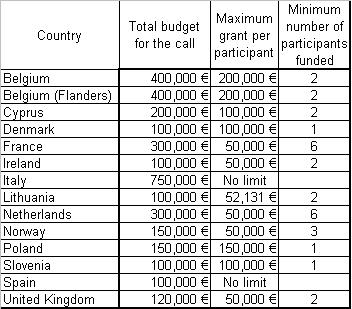
What are JPIs?
Joint Programming Initiatives are the European Union's attempt to do common research beyond the Framework Programme, a sort of back door to tapping the far greater resources allocated to national research. Thus, from 2008 to 2010 different JPIs established consortia consisting of national funding agencies, regarding different themes.
The first successful JPIs were approved by the European Council on October 2010. Among them: Agriculture, Food Security and Climate Change, A Healthy diet for a Healthy life; and Cultural Heritage and Global change. These were the first three of today's 10, which are listed and linked below:
- Neurodegenerative Diseases/Alzheimer's.
- Agriculture, food security and climate change.
- A healthy diet for a healthy life.
- Cultural heritage & global change.
- Urban Europe.
- CliK'EU (Climate Knowledge).
- More years, better lives.
- Antimicrobial resistance (no website yet, more information on its development here).
- Water challenge.
- Healthy & productive seas and oceans.
JPI-CH
Now that we have reviewed what JPIs are, the subject of this post is that recently Cultural Heritage became the third JPI to launch a call for proposals (Urban Europe closed its first call in September, and Neurodegenerative Diseases has been making calls since 2011).
The Joint Heritage European Programme is a 3-year support action which started with 2011, and is in charge of designing and implementing the JPICH research strategy.
JPI-JHEP Joint Pilot Call
As a result, on January 10 the JPI-JHEP Joint Pilot Call was launched with the following topics:
- Methods, tools (including non-invasive instruments) and modelling for understanding damage and decay mechanisms (including the effects of weathering and climate change) on tangible heritage (including buildings, sites and landscapes);
- Materials, technologies and procedures for the conservation of tangible cultural heritage;
- Use and re-use of buildings and landscapes, including the relationship between changes of use and public policy, including costs and added value (for example as a result of planning regulations and urban development);
- Increasing understanding of cultural values, valuation, interpretation, ethics and identity around all forms of cultural heritage (tangible, intangible and digital heritage).
There is an important issue to take into account, though. The nature of JPIs is that participating countries use national funds to fund their partners. Therefore, these calls follow strict national guidelines. These can be seen in Annex 1 of the Guide for Applicants. These guidelines include how much funding, and what activities will be funded. I have decided to summarize the key aspects (funding) by country, so all the information can come to light:
As you can see here, funding is not really what was expected. Also, if we consider that projects can request up to 3 million EUR, then you can imagine how many partners they have to include. In fact, if the national budgets are added, we see that only 3.27 million EUR have been allocated. Generous? In my opinion, if calls go like this, this JPI will soon be dead in the water.
But there is no need to be sad. After all, a new call has been opened! It will be easy to expect small consortia and 6 projects requesting less than 0.5 million EUR. Not too bad, considering it is a pilot call.
The call closes on April 5. It is important to review the guidelines in the Guide for Applicants, and fill the application form template.
But there is no need to be sad. After all, a new call has been opened! It will be easy to expect small consortia and 6 projects requesting less than 0.5 million EUR. Not too bad, considering it is a pilot call.
The call closes on April 5. It is important to review the guidelines in the Guide for Applicants, and fill the application form template.


 RSS Feed
RSS Feed